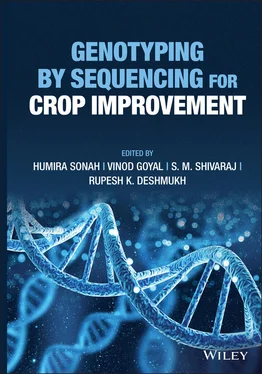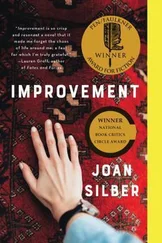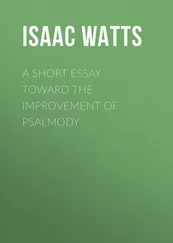Genotyping by Sequencing for Crop Improvement
Здесь есть возможность читать онлайн «Genotyping by Sequencing for Crop Improvement» — ознакомительный отрывок электронной книги совершенно бесплатно, а после прочтения отрывка купить полную версию. В некоторых случаях можно слушать аудио, скачать через торрент в формате fb2 и присутствует краткое содержание. Жанр: unrecognised, на английском языке. Описание произведения, (предисловие) а так же отзывы посетителей доступны на портале библиотеки ЛибКат.
- Название:Genotyping by Sequencing for Crop Improvement
- Автор:
- Жанр:
- Год:неизвестен
- ISBN:нет данных
- Рейтинг книги:4 / 5. Голосов: 1
-
Избранное:Добавить в избранное
- Отзывы:
-
Ваша оценка:
- 80
- 1
- 2
- 3
- 4
- 5
Genotyping by Sequencing for Crop Improvement: краткое содержание, описание и аннотация
Предлагаем к чтению аннотацию, описание, краткое содержание или предисловие (зависит от того, что написал сам автор книги «Genotyping by Sequencing for Crop Improvement»). Если вы не нашли необходимую информацию о книге — напишите в комментариях, мы постараемся отыскать её.
A thoroughly up-to-date exploration of genotyping-by-sequencing technologies and related methods in plant science Genotyping by Sequencing for Crop Improvement,
Genotyping by Sequencing for Crop Improvement
Genotyping by Sequencing for Crop Improvement
Genotyping by Sequencing for Crop Improvement — читать онлайн ознакомительный отрывок
Ниже представлен текст книги, разбитый по страницам. Система сохранения места последней прочитанной страницы, позволяет с удобством читать онлайн бесплатно книгу «Genotyping by Sequencing for Crop Improvement», без необходимости каждый раз заново искать на чём Вы остановились. Поставьте закладку, и сможете в любой момент перейти на страницу, на которой закончили чтение.
Интервал:
Закладка:
3.4 Whole‐Genome Pooled Sequencing
Genotyping populations with NGS technologies are very convenient and appealing (Unamba et al. 2015). Whole‐genome pooled sequencing popularly known as Pool‐seq has been used to sequence multiple individuals instead of single individuals from a population separately (Fracassetti et al. 2015). The main advantage is that large number of samples can be assayed in a cost‐effective manner. But sometimes, pooling is necessary when separating individuals is difficult and when sufficient DNA is not there to create individual libraries. Pooling is used for the estimation of SNP frequencies in population genetics. Pooling approach has been applied to study genetic loci governing a trait, to perform GWAS (Bastide et al. 2013), and to gather demographic history of population (Hellwege et al. 2017). During statistical analysis, random experimental errors in measuring allele frequencies from pooled DNA should be considered. Sophisticated pooling designs are being developed in order to take care of hidden population stratification, confounders, and interactions, allowing the analysis of haplotypes (Sham et al. 2002; Norton et al. 2004). Fracassetti et al. (2015) verified a pooled whole‐genome resequencing (Pool‐seq) technique on Arabidopsis lyrata in which only 1.6 ng DNA per individual was used for library preparation. They compared the SNP frequencies, acquired by pooling to those generated by individual‐based genotyping‐by‐sequencing (GBS), and found, Pool‐seq as a viable approach for obtaining population‐level SNP frequency data with good accuracy in a larger number of samples. They also examined the effects of sample size, sequencing depth per individual, and variant caller on population SNP frequency estimations. Since differential amplification occurs for many SNPs, and this biasness should be rectified during the estimation of allele frequency from pooled DNA (Sham et al. 2002; Norton et al. 2004). Whole‐genome sequencing of pooled F2 individuals has been used to identify mapping interval and candidate gene SNPs in maize (Klein et al. 2018).
NGS technique in combination with whole‐genome shotgun sequencing can be used to genotype nonmutant Vs. mutant bulked segregant analysis (BSA) pools at markers across the genome (Klein et al. 2018). With the advent of NGS, even without precise mapping, BSA may be utilized to immediately identify a very narrow mapping interval, causative lesion, and so forth. The genomic interval containing the mutant gene of interest can be discovered using BSA‐Seq data (Hill et al. 2013). In a pooled BSA sample, the unlinked marker will be genotypically heterozygous, unless F1 recombination has occurred between the mutant lesion and a specific marker, while the linked markers will be homozygous for the mutant parent genotype. BSA‐Seq is a useful approach for genome reduction that allows to increase sequencing depth without raising costs.
3.5 Pinpointing Gene Through Whole‐Genome Resequencing‐based QTL Mapping
The NGS has been used for QTL mapping and pinpointing the genes of interest. QTL mapping approaches solve the issues caused by repetitive sequences and genome duplication in addition to combining SNP discovery, SNP validation, and genotyping (Xu et al. 2013). Huang et al. (2009) showed that QTL affecting plant height were linked to a region where the green revolution gene is situated (Huang et al. 2009; Xu et al. 2013). Rice recombinant inbred lines (RIL) populations were genotyped with the help of WGR (Huang et al. 2009). In rice, QTL mapping precision for grain width was evaluated from previously cloned QTL possessing the gene GW5 for grain width found to be localized in bin, its presumed genomic location (Xie et al. 2010). The complexity of the genome of some species for example soybean (paleopolyploid) hinders the applications of sequencing‐based genotyping approaches. Since, due to two genome duplication events, 75% of the genes are present in multiple copies (Schmutz et al. 2010). These paralogs further pose issues due to the short sequence reads which cause undistinguished allelic variations. Besides, the abundant repetitive sequences, heterochromatic regions of soybean genome, provide technological challenges for sequence alignment. Using 246 RILs sequenced at an average depth of 0.19× (Xu et al. 2013). Using 246 RILs sequenced at an average depth of 0.19, Xu et al. (2013) employed NGS methods to find QTL for southern root‐knot nematode (RKN) resistance in soybean. They identified and validated SNPs. RIL population was genotyped as well as the parental source of each SNP allele was deduced. Linkage map was subsequently established using 3509 bins and 3489 recombination intervals as molecular markers. Out of three QTLs identified, one major QTL was 29.7 kb in size and mapped to bin 10 of chromosome 10. This QTL possess three true and two pseudogenes. As a result of sequence differences and gene expression analyses, the RKN resistance candidate genes Glyma10g02160 and Glyma10g02150 were identified which encodes for pectin methylesterase inhibitor‐pectin methylesterase and pectin methylesterase inhibitor, respectively. This method is widely used to enhance QTL mapping accuracy in crops with a reference genome.
3.6 Online Resources for Whole‐Genome Resequencing Data
3.6.1 SNP Seek
SNP seek database is a user‐friendly database that provides access to SNPs. Rice SNP seek database ( www.snp‐seek.irri.org) contains SNP genotyping data for 3K rice varieties obtained from 3000 Rice Genomes Projects (Locedie et al. 2016). About 20 million rice SNPs were identified from this Project for 3K rice variety sets against the reference Nipponbare genome (Alexandrov et al. 2015). We can use the interface to identify SNPs using gene ID (MSU locus name) or genomic region by specifying chromosome, start and end sites. This site also provides phenotype and variety information for 3K rice varieties from the International Rice Genebank Collection Information System (IRGCIS) (Locedie et al. 2016).
3.6.2 Rice Functional and Genomic Breeding
Rice Functional and Genomic Breeding (RFGB, www.rmbreeding.cn) is a user‐friendly database developed for breeding applications based on SNPs and InDels from 3000 rice genome projects. RFGB database bridges gap between phenotypic and genotypic data sets of the sequenced genome (Chun‐Chao et al. 2019). The RFGB database contains five major modules including Phenotype, Haplotype, SNP & InDel, Restore sequence, and Germplasm. Users can search variations (SNPs, InDel) using gene locus ID (ex. Os05g0187500, LOC_Os09g26999), chromosome region (ex. Chr1, 200001–500000), and keywords (ex. GW5, heading date). Further, haplotype analysis can be done using gene locus ID, chromosome region, and SNP sites (ex. Chr2‐8120893) (Chun‐Chao et al. 2019).
3.6.3 Genome Variation Map
The genome Variation Map ( www.ngdc.cncb.ac.cn/gvm/home) is a data repository and retrieval system of genome variations in BIG Data Center ( www.ngdc.cncb.ac.cn). It provides free open access to search for SNPs and short InDels from approximately 609 million genome variants for 25 plants, 13 animals, and 3 virus species. The current version of the Genome Var Map includes a total of 41 species, 202 projects, 64819 samples, 9 60 409 451 variants, 2 60 393 associations, and 95 submissions (Li et al. 2021). Users can retrieve variants by variation IDs, genomic coordinates, gene names, gene functions, and variant effects. The results can be downloaded directly in FASTA or VCF file formats.
3.7 Applications and Successful Examples of Whole‐Genome Resequencing
One of the important applications of whole‐genome resequencing is to explore the genetic diversity at the sequence level. Rice has known to be species that shows genetic diversity not at species level but within the genus as well. The 3000 rice genome sequencing has led to the capture of the sequence variation in the genome which aids to decipher population differentiation (local and global population), construct new reference genome, pan‐genome of varieties, haplotyping, and SNP discovery (Li et al. 2014b). Further, previously characterized genes have also been analyzed for haplotype diversity which can be employed in haplotype‐based breeding (Abbai et al. 2019). Another example includes the study of evolutionary history by genome resequencing in peach fruit (Yu et al. 2018).
Читать дальшеИнтервал:
Закладка:
Похожие книги на «Genotyping by Sequencing for Crop Improvement»
Представляем Вашему вниманию похожие книги на «Genotyping by Sequencing for Crop Improvement» списком для выбора. Мы отобрали схожую по названию и смыслу литературу в надежде предоставить читателям больше вариантов отыскать новые, интересные, ещё непрочитанные произведения.
Обсуждение, отзывы о книге «Genotyping by Sequencing for Crop Improvement» и просто собственные мнения читателей. Оставьте ваши комментарии, напишите, что Вы думаете о произведении, его смысле или главных героях. Укажите что конкретно понравилось, а что нет, и почему Вы так считаете.












